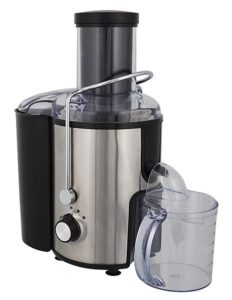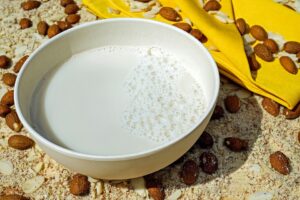
Which type of juicer should I use?
If you do not have a juicer yet and want to give it a go, perhaps buy a low budget one first. If you get serious, you will probably want to get a good quality juicer.
The best juicers on the market are the juicers that masticate as they contain twin gears which crush the food and forces it through a strainer. See more detailed information below.
Preparation is key, and yes, there is a fair amount of preparation time as you need to cut the veggies into smaller pieces before juicing them, but it is totally worth it! It expels much less waste, unlike other non-masticating juicers and you can taste the difference. You can also store your freshly pressed juice for up to 24 hours in the fridge.
When I first started juicing, I used a very ordinary juicer, given to me by a friend as she was not using it anymore – I remember it expelled more waste than juice.
So, as I was serious about juicing having learnt about their healing benefits, I decided not to waste any more time and invested in a Champion Juicer.

It was OK to start with, as it’s a very reasonably priced juicer and in in comparison makes much more juice than the low budget juicers. However, the masticating juicers, such as the Green Star juicer, are the best for those that take their juicing quite seriously and use juice as a vital part of their healthy lifestyle.
Masticating juicers
The masticating juicers operate at a much slower speed and also have the capability to be used as a grinder for nuts, sprouted grains, seeds or dried fruits to produce nut butters, frozen ice creams and sorbets.
So, the Green Star juicer, was my next juicer. I bought and had it shipped from the USA in 2008 and although it is now pretty old, it is still working efficiently up to this day!
See below a comparison of the pros and cons of the Green Star juicer and centrifugal juicers.
The Green Star juicer
Pros: These juicers are generally more efficient as they produce much more juice than centrifugal juicers, leaving behind a very dry pulp.
They will also extract juice from wheatgrass, spinach, kale, parsley, and similar vegetables. They are less noisy.
 They work at slower speeds than centrifugal juicers and the juice is exposed to less heat. Using twin gears that revolve at only 110rpm, it pushes the food down between the gears and presses the juice into an airtight chamber, without pumping oxygen into the juice. Juice made this way will keep for much longer periods without breaking down.
They work at slower speeds than centrifugal juicers and the juice is exposed to less heat. Using twin gears that revolve at only 110rpm, it pushes the food down between the gears and presses the juice into an airtight chamber, without pumping oxygen into the juice. Juice made this way will keep for much longer periods without breaking down.
This is ideal if you don’t want to consume the juice immediately. You could refrigerate it for up to 24 hours (juice from an Angel Juicer, one of the most expensive juicers around, can last even longer – I think up to 3 days – without losing much of its nutritional value).
Laboratory reports say that the Green Star juicer, produces approx. 300ml (1/2 pint) more juice from a 5lb bag (approx. 2.3kg) of carrots than centrifugal juicers.
Not only does it do a great job juicing but it also can be used to make baby foods, spreads, nut butters, ice creams and fruit sorbets. Yes – all this with one machine. Cool isn’t it? I just love my juicer ;-).
Cons: The Green Star juicer requires more effort to clean it and has a smaller feeder tube so you need to cut your produce into smaller pieces.
Centrifugal juicers
 Generally good for juicing soft and hard fruits and vegetables but not ideal for leafy greens.
Generally good for juicing soft and hard fruits and vegetables but not ideal for leafy greens.
Centrifugal type juicers cut the fruit or vegetable into little pieces, and then use centrifugal force to push the pulp against a strainer.
It does this by spinning it at a very high speed. This process is similar to wet clothes in your washing machine on the spin cycle.
Pros: They are very fast, quite cheap to buy and easy to clean.
Cons: They are very noisy and produce less juice – more waste than juice!
Also, they are not good at juicing green leafy vegetables like spinach, kale, wheat grass, parsley and similar vegetables.
They also speed up the oxidation of enzymes and vitamins and therefore impact on the nutritional value of the juice. Therefore, the juice should be consumed within 15 minutes and can’t be stored for longer without losing its nutritional content.
A quick tip
Try to avoid a common trap that most people fall into which is to drink your juice with your meal. Instead drink your fresh juice on an empty stomach or at least 30 minutes before your meal so the juice can assimilate the nutrients in your body.
Drinking juice with meal is a no, no!
Juicing is one of the easiest ways to make your lifestyle much healthier.
Also, please note that organic ingredients are always preferable. Organic food is better for your health and our environment. Choose organic to ensure that your children have a healthier future and help to save our planet!
If you like to learn more please check out my book ‘Healing Beverages’ which has over 100 delicious and simple recipes for juices, smoothies, plant-based milks and herbal teas, plus lots of other helpful information. 😉
 Previous Post
Previous Post Next Post
Next Post



Fantastic Site. Really enjoyed reading.
Thank you for your comment. I am glad you like my website. 😉